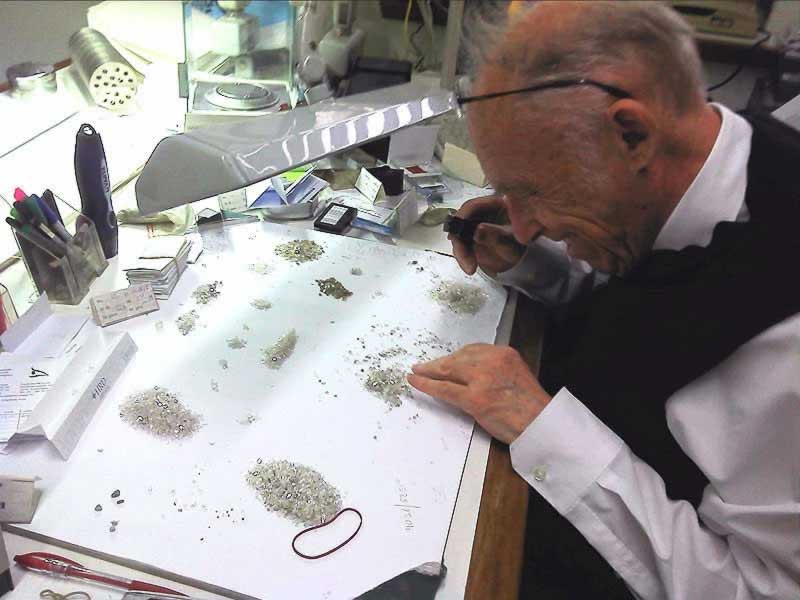|
Although the
diamond is the hardest gem known to man, its composition is a simple one: it
is common carbon, like the graphite of pencils, but with a structure that
involves a fusion point of 6900 degrees Fahrenheit, that is two times the fusion
point of steel. Billions of years ago the elementary forces of heat and pressure
transformed carbon into diamond. The volcanic mass in which this crystallization
happened increased and came through the land crust cooling itself in the
kimberlitic fireplaces. It is in fact in these kimberlitic fireplaces that
diamonds are still found today
|
|
 |
There are 4
main characteristics to be taken into consideration for a correct appraisal of a
diamond:
All four,
or importantly their combination, confer to a diamond their uniqueness and
determinate internationally a fair market value.
Following is a brief description of how these characteristics and how they
effect the value of precious stones.
The colour
of a diamond is perhaps its most appreciable characteristic, also to eye. The
more the diamond is white and more light can be reflected crossing it. Obviously
this quality greatly affects every stone’s value determining the price of a
diamond.
A diamond of colour H or G (that is with an optimal white
colour) can cost up
to 50%
more than a stone of I colour
other characteristics being
equal (cut, carats and purity). The appraisal of the colour of a diamond is
extremely difficult and is carried out with the aid of coloured stones called “comparison
stones”.
Various scales of appraisal of the colour of diamonds exist, one of the most used
is the GIA scale (
Gemological institute of America
) that we summarize as follows.
|
GIA diamond colour scale grade
|
|
|
|
|
|
|
|
|
| D E F |
G H |
I J K |
L M N |
O P |
Q R |
S==> Z |
| Exceptional White |
Rare White |
Slightly Tinted White |
Tinted White |
Tinted Coloured
|
18Carati uses only G colour Vs clarity diamonds.
|
The cut of
a diamond represents in the last analysis the ability of a stone to reflect
light in an optimal way and it determines therefore the brilliance. It is a
common mistake to confuse the cut with the shape (which we talk about later).
The most common shape is without a doubt "the brilliant cut", that is of
round shape on the top. When observing an ideally cut stone, the light enters
from the top part of a diamond as refracted to straight angle the in order to
leave from the same part giving the stone a remarkable brightness and
"brilliance" (see diagram): The classic brilliant cut comprises 58 facets 33 of
which located on the top part (or crown) and 25 on the bottom part (or
pavilion). When the crown represents a third of the total height of the diamond,
the best brilliance is obtained.
| |
|
|
|
| Different
types of diamond cut |
| |
 |
 |
 |
 |
 |
 |
 |
|
Round
|
Princess
|
Emerald
|
Radiant
|
Oval
|
Drop
|
Marquise
|
| |
|
|
|
|
|
|
The purity of
a diamond is an important factor when determining the value. Diamonds without
inclusions, that is totally without punctiform imperfections inside that are
visible with 10X magnifying glass are real rarity.
Small imperfections called inclusions are very common. The smaller the
inclusions (or their absence) determines how precious and valuable our stone
will be.
It goes without saying that the differences in purity between similar stones are
much difficult to establish by a layman and only a gemologist, with the aid of
special white light and magnifying glass, is able to establish if a diamond is
a Vvs2 (Very very small inclusions) rather than a Vs1 (Very
small inclusions). To the eyes of layman they can appear identical when in fact
there are remarkable differences in value.
For this reason it is always advisable to purchase diamond jewellery from
trustable and expert traders. Always ask to know the characteristics of the
diamond that you wish to acquire.
| |
|
|
| GIA - Diamone Purity Scale |
| |
|
|
When
talking about diamonds (or more in general of precious stones) the carat is
simply the unit used to measure its weight and is equivalent to a fifth of gram
(0,20 grams). Be careful not to confuse the carat meaning the measurement of the
purity (or fineness) used in precious metals such as gold or platinum which we
will speak about later.
The carat, generally abbreviated in Ct. ,
constitutes the measurement of the weight of a precious stone. In the following
table, we give approximate dimensions of round cut diamonds (called brilliant
cute), which corresponds to given carat value.
The carat
of a stone is also important in determining its value and not only because
obviously the value increases as the carat increase,
but also because bigger stones cost much more than the equivalent weight made of
smaller stones. That means for instance that a one carat single stone (Ct. 1.00)
is a lot more valuable then 100 stones of 1 point of a carat (Ct. 0.01).
Referring to the carat of diamonds “points” are often mentioned; The point of
carat is the hundredth part of the carat (= 0,002 grams) and it is often used
for weighing of very small diamonds .

|